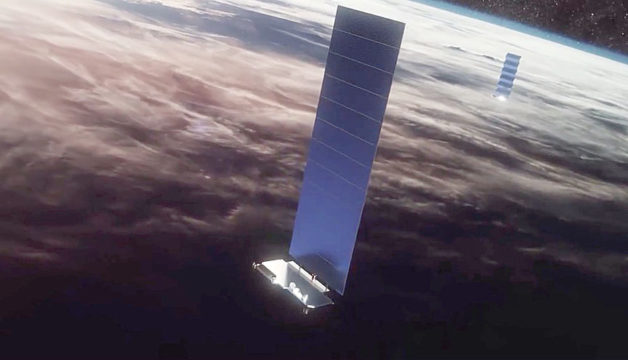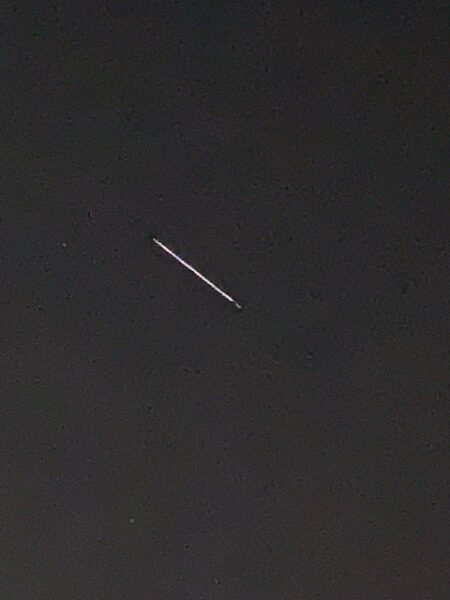Changes to the design of Starlink satellite spacecraft have made them brighter again, though still dimmer than the original design.

SpaceX
SpaceX has launched more than 2,000 Starlink internet satellites since 2019, and the company plans to orbit thousands more in the near future. Astronomers are concerned that these megaconstellations of bright spacecraft will seriously interfere with celestial observations for professionals and amateurs alike.
In order to address the problem, SpaceX voluntarily began installing sunshades on their Starlink satellites two years ago. These so-called VisorSats are about 1.3 magnitudes dimmer than the original satellites, as reported in Sky & Telescope. But now, new technological requirements have resulted in visors being omitted from a new generation of Starlink satellites launched since late last year. Alexandra Witze reported in Nature that the newest satellites use laser communication instead of radio links; while the sunshades were transparent to radio frequencies, they block laser light.
SpaceX engineer David Goldstein discussed these design changes at a recent webinar organized by the Federation of Astronomical Societies, adding that the company has developed dielectric mirrors for the Earth-facing side of the Starlink chassis, designed to reflect sunlight away from observers directly below the spacecraft.
In order to test how the brightness of the latest Starlink spacecraft (those with ID numbers above 3000) compare to VisorSats, I analyzed magnitudes recorded this year by Jay Respler, an accomplished satellite observer. The average visual magnitude measured for 58 Series-3000 satellites is 5.60, brighter than the average magnitude of 6.29 measured for 44 VisorSats.
Both a satellite’s distance from the observer and its angle relative to the Sun influence its brightness. After adjusting the observed magnitudes for these parameters, I found that the Series-3000 spacecraft are about 60% brighter than VisorSats. And even the VisorSat design had still exceeded the 7th-magnitude limit recommended by astronomers to minimize both interference with research and naked-eye enjoyment of the night sky. However, the Series-3000 satellites still represent an improvement of about 0.8 magnitudes compared to the original Starlink satellites.

Anthony Mallama
It’s worth noting that Starlink satellites can sometimes appear far brighter than mentioned already, shortly after they're launched in batches of 50 or so. One recent sighting was reported by WKBN News in northeast Ohio. Dozens of members of the public alerted the media outlet after seeing a line of bright lights in the sky on the evening of April 21st. Those lights turned out to be Starlink satellites from the group designed G4-14, which had launched earlier that day.
Amateur astronomer, Gus Saikaly, described his view of G4-14 to me and sent the photograph below. He estimated the satellites’ individual magnitudes as -3 and likened them to a “string of Jupiters.” Such a dazzling train of spacecraft would spoil observations of almost any astronomical object.

In another worrisome development, SpaceX plans an entirely new version of Starlink that’s larger than the current model. In this video, SpaceX CEO Elon Musk announced that Starlink 2.0 would be 7 meters long and weighs 1.25 tons. The new model is so large and heavy that it will require a bigger and more powerful rocket than the Falcon 9, which currently launches the satellites. The Starlink 2.0 spacecraft will instead fly on SpaceX’s super heavy-lift Starship rocket. While their design will take light reflection into account, these future Starlinks could nevertheless end up exceeding the brightness of current ones.
Astronomers, Unite
Astronomers are not sitting by idly while SpaceX and other space-internet companies such as OneWeb populate the sky with spacecraft. The International Astronomical Union is establishing a Centre for Protection of the Dark and Quiet Sky from Satellite Constellation Interference. This web-based resource, under the management of astronomers Piero Benvenuti, Connie Walker and Federico Di Vruno, will serve as a resource for all stakeholders in the effort to preserve dark skies. The Centre will be a vital hub for astronomers as other entities including Amazon and the Chinese government pursue their own plans for space-based internet infrastructures.
 13
13









Comments
[email protected]
June 12, 2022 at 7:35 am
This is very disappointing news as an astrophotographer. Currently I see satellites in my sub exposures almost every time i'm out imaging, and now it sounds like this is only going to get worse. Where does this end? is this another greed driven runaway train that pollutes yet another one of earth's natural wonders? This is absolutely heart breaking.
You must be logged in to post a comment.
Anthony-Mallama
June 13, 2022 at 10:44 am
There is a data repository for FITS images with satellite streaks. They may he uploaded at this web-site: https://trailblazer.dirac.dev/.
You must be logged in to post a comment.
Len Philpot
June 17, 2022 at 5:35 pm
I'm not an astrophotographer and it's just as concerning, not to mention the ever increasing density of orbital objects which have many other serious concerns. Unfortunately despite efforts otherwise, it seems space is -- to a large degree -- the new 'wild west' if you have enough money and / or influence.
You must be logged in to post a comment.
Anthony Barreiro
June 12, 2022 at 7:14 pm
Thank you for this detailed objective report. I don't have any hard numbers, but just subjectively, the satellites are getting more numerous and brighter. I look at the sky regularly with 10x42 binoculars in the evening and before and during dawn. I used to see a few satellites over the course of half an hour. Now looking at any five-degree diameter field in the sky for less than one minute, I'm almost guaranteed to see at least one satellite sixth magnitude or brighter.
You must be logged in to post a comment.
Anthony-Mallama
June 13, 2022 at 9:31 am
Thanks for your comments, Anthony. The number of artificial satellites visible in the sky at any given time could be computed from our knowledge of their brightness and their orbits. Then one could determine how much that number has changed in recent years. The result would be interesting and important to professional and amateur observers.
You must be logged in to post a comment.
Anthony Barreiro
June 14, 2022 at 1:18 pm
Today's Astronomy Picture of the Day is a two-hour exposure of the sky over Australia. More satellite trails than you can count. If you mouse over the image, the different satellites are identified. Most of them are Starlink.
https://apod.nasa.gov/apod/ap220614.html
You must be logged in to post a comment.
Paul Celentano
June 17, 2022 at 4:46 pm
Hi Anthony. That's a fascinating photograph. If it is a 2 hour exposure (assuming the camera tracked the sky), how are the terrestrial objects not blurred? I'm not doubting... just asking. I'm am just getting back into being an amateur but avid shutterbug so I'm a little rusty. Thanks in advance.
You must be logged in to post a comment.
Monica Young
June 22, 2022 at 1:37 pm
Hi Paul, from the photograph's description, it's a composite, so the foreground and satellite trails were taken separately (over the same time period but I gather not with the same exposure time) and then combined.
You must be logged in to post a comment.
Stephen Gagnon
June 17, 2022 at 8:21 pm
Most satellites in orbit are Starlink, so...
You must be logged in to post a comment.
Alex86a
June 18, 2022 at 12:45 pm
Astronomy is over...
When in a few years there will be 100,000 satellites, there will be nothing left to observe...
I say this as an amateur astronomer, disappointed and resigned...
You must be logged in to post a comment.
Warren-Odom
June 18, 2022 at 9:20 pm
Everyone is talking about visual interference, which occurs mainly "near" sunrise and sunset (where "near" is a squishy and variable amount, I know). But it also occurs to me that radio telescopes, such as the Very Large Array and others, could experience radio interference at ALL hours of the night and day. I know the VLA (and I imagine others) is built where mountains ring the site to protect against artificial radio signals, but those mountains don't work against aerial sources.
You must be logged in to post a comment.
Martian-Bachelor
June 26, 2022 at 3:10 pm
Before our white brothers arrived to make us civilized men, we didn't have any kind of prison. Because of this, we had no delinquents. We had no locks nor keys and therefore among us there were no thieves. When someone was so poor that he couldn't afford a horse, a tent or a blanket, he would, in that case, receive it all as a gift. We were too uncivilized to give great importance to private property. We didn't know any kind of money and consequently, the value of a human being was not determined by his wealth. We had no written laws laid down, no lawyers, no politicians, therefore we were not able to cheat and swindle one another. We were really in bad shape before the white men arrived and I don't know how to explain how we were able to manage without these fundamental things that (so they tell us) are so necessary for a civilized society.
― Lame Deer
I have a dream! Maybe his Tweeter take-over will turn into the debacle it's shaping up to be, Musk will go bankrupt, and be forced to bring all this junk down so it can be salvaged and sold off. I suppose it's too much to think he'll ever develop a conscience.
You must be logged in to post a comment.
Brad Young
July 18, 2022 at 2:21 am
Nice article, Jay has done a LOT of good observing. It will be nice when the IAU site is open and we can start processing more observations. I published an article in Reflector Magazine https://www.astroleague.org/files/reflector/MARCH%202022%20REFLECTOR%20pages.pdf
page 25 that may help observers measure the brightness themselves, and provide Jay Respler level of information to be used for future analysis, especially with a new configuration being launched
You must be logged in to post a comment.
You must be logged in to post a comment.